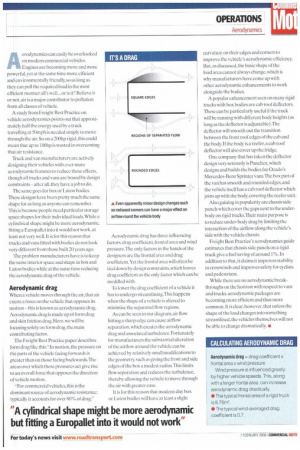BIT OF A JAG
Page 40

Page 41

If you've noticed an error in this article please click here to report it so we can fix it.
Dylan Gmlooks at why aerodynamics are so
important on modern commercial vehicles and how the smallest of changes can have a major impact.
Aerodynamics can easily be overlooked on modern commercial vehicles. Engines are becoming more and more powerful, yet at the same time more efficient and environmentally friendly, so as long as they can pull the required load in the most efficient manner all's well.., or is it? Believe it or not, air is a major contributor to pollution from all classes of vehicle.
A study from Freight Best Practice on vehicle aerodynamics points out that approximately half the energy used by a truck travelling at SOmph is needed simply to move through the air. So on a 200hp rigid, this could mean that up to 100hp is wasted in overcoming that air resistance.
Truck and van manufacturers are actively designing their vehicles with ever-more aerodynamic features to reduce these effects, though all trucks and vans are bound by design constraints —after all, they have a job to do.
The same goes for box or Luton bodies. These designs have been pretty much the same shape for as long as anyone can remember. 'Ibis is because people need particular storage space shapes for their individual loads.While a cylindrical shape might he more aerodynamic, fitting a Europallet into it would not work, at least not very well. It is for this reason that trucks and vans fitted with bodies do not look very different from those built 20 years ago.
The problem manufacturers have is to keep the same interior space and shape in box and I ,uton bodies while at the same time reducing the aerodynamic drag of the vehicle.
Aerodynamic drag
When a vehicle moves through the air, that air exerts a force on the vehicle that opposes its motion —this is known as aerodynamic drag. Aerodynamic drag is made up of form drag and skin friction drag. Here, we will be focusing solely on form drag, the main contributing factor.
The Freight Best Practice paper describes form drag like this:"In motion,the pressure on the parts of the vehicle facing forwards is greater than on those facing backwards.The areas over which these pressures act give rise to an overall force that opposes the direction of vehicle motion.
"For commercial vehicles, this is the dominant source of aerodynamic resistance: typically it accounts for over 80% of drag. Aerodynamic drag has three influencing factors: drag coefficient, frontal area and wind pressure.The only factors in the hands of the designers are the frontal area and drag coefficient. Yet the frontal area will often be tied down by design constraints, which leaves drag coefficient as the only factor which can be meddled with.
To lower the drag coefficient of a vehicle it has to undergo streamlining.This happens when the shape of a vehicle is altered to minimise the separated flow regions.
As can be seen in our diagram, air flow hitting a sharp edge can cause airflow separation, which creates the aerodynamic drag and associated turbulence. Fortunately for manufacturers the substantial alteration of the airflow around the vehicle can be achieved by relatively small modifications to the geometry, such as giving the front and side edges of the box a modest radius.This limits flow separation and reduces the turbulence, thereby allowing the vehicle to move through the air with greater ease.
It is for this reason that modern-day box or Luton bodies will have at least a slight curvature on their edges and corners to improve the vehicle's aerodynamic efficiency. But, as discussed,the basic shape of the load area cannot always change, which is why manufacturers have come up with other aerodynamic enhancements to work alongside the bodies.
A popular enhancement seen on many rigid trucks with box bodies are cab roof deflectors. These can be particularly useful if the truck will be running with different body heights (as long as the deflector is adjustable ).The deflector will smooth out the transition between the front roof edges of the cab and the body. If the body is a reefer, a cab roof deflector will also cover up the fridge.
One company that has taken the deflector design very seriously is Paneltex. which designs and builds the bodies for Ocado's Mercedes-Benz Sprinter vans.The box part of the van has smooth and rounded edges, and the vehicle itself has a cab roof deflector which joins up with the body covering the reefer unit.
Also gaining in popularity are chassis side panels which cover the gaps next to the underbody on rigid trucks.Their main purpose is to reduce under-body drag by limiting the interaction of the airflow along the vehicle's side with the vehicle chassis.
Freight Best Practice's aerodynamics guide estimates that chassis side panels on a rigid truck give a fuel saving of around 1')/0. In addition to that, it claims it improves stability in crosswinds and improves safety for cyclists and pedestrians.
While there are no aerodynamic breakthroughs on the horizon with respect to vans and trucks, aerodynamic packages are becoming more efficient and thus more common. It is clear, however, that unless the shape of the load changes into something streamlined, the vehicles themselves will not be able to change dramatically. •








































































































































































